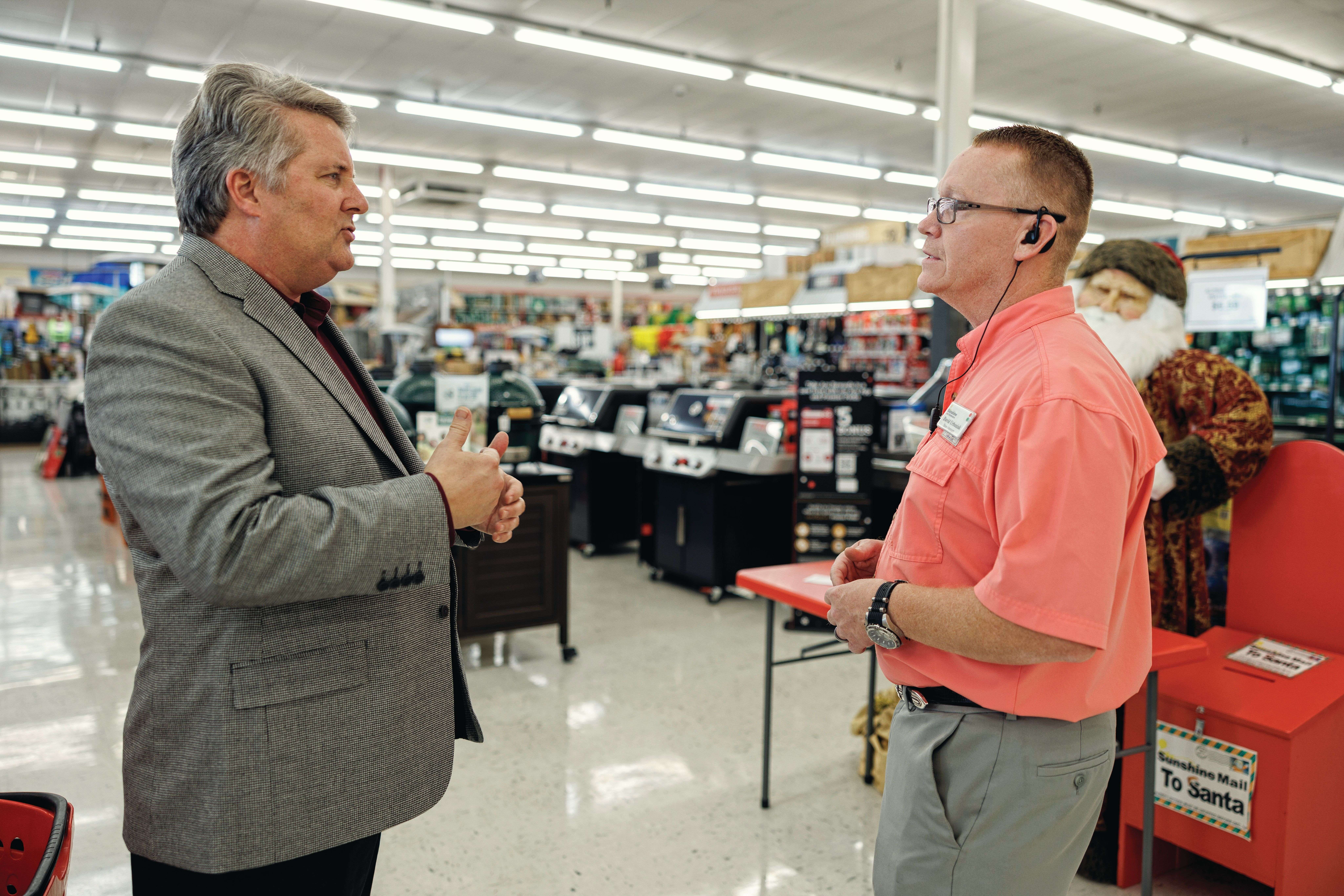After Hurricane Ian hit, the management team at Sunshine Ace Hardware reached out to their 316 employees. The team asked about employees’ safety, their families’ safety, their homes. Then they just asked a simple question: How are you?
It’s a simple question but a loaded one. Mentally, the American worker has not been doing well. Stress levels have already been high because of the pandemic and its repercussions—and locally, the hurricane that made landfall on Sept. 28, 2022, significantly exacerbated the issue.
Sunshine Ace has tried to make the mental health of its employees a priority over the last few years. So in addition to physical safety after the storm, the company focused on mental well-being, too. It turned out that while all employees were safe, 12 had lost their homes.
Sunshine Ace already had an account set up with the Community Foundation of Collier County that can provide grants to employees in times of need, and was exploring other ways to help its employees financially. But the event has been traumatizing to many employees, even the ones who escaped harm or were relatively safe. The company worked to connect employees to mental health resources, including exploring the possibility of bringing in therapists for on-site sessions.
“We want to make sure they feel like they’re not alone,” says President Michael Wynn.
Sunshine Ace is among the businesses that are putting the once-taboo topic of mental health out into the open. The health scares of the pandemic, mixed with a hostile political climate and the financial strain of ongoing inflation, have created an atmosphere that’s unsettled the nation.
About 76% of American workers showed symptoms of at least one mental health condition in 2021, up from 59% in 2019, according to Mind Share Partners, a nonprofit that focuses on promoting mental health awareness in the workplace. Anxiety, depression and burnout were the most common conditions noted—but obsessive-compulsive disorder, eating disorders and PTSD were among the conditions that were becoming more common (see pg. 35). The workplace isn’t the only cause of all of these issues. But the vast majority of respondents reported at least one issue from work negatively affecting their mental health, whether their work was emotionally draining or interfering with their home life (see pg. 32). Plus, when people are experiencing symptoms, they’re experiencing them for longer. In 2019, only about half of respondents reported a symptom that lasted for longer than a week. In 2021, it was 80%.
Pre-Ian, Sunshine Ace and other businesses partnered with the David Lawrence Centers in Naples for its Mind Your Mind campaign, launched early last year after the nonprofit’s leadership noticed the decline in mental health across all sectors during the pandemic. DLC has hosted seminars on workplace mental health and provided support to employers on what they can do to take care of their teams. “There is no overall health without mental health,” says CEO Scott Burgess.
The old workplace mindset about mental health was this: Don’t talk about it. And many businesses felt that was the way to success, too; that any change in culture could make the business less successful. But the result of that way of thinking is the promotion of a toxic workplace that will drive people away, said Bill Greene, a principal with Mind Share Partners. “If you continue with that mentality, you will lose people,” he says.
Mind Share Partners started pre-pandemic with the intention of reducing the stigma around mental health discussions in the workplace. There’s the human element of just making sure your employees are in a good place, but it’s also a productivity issue. Mind Share Partners found that poor mental health leads to an increased number of employees leaving jobs, taking more time off and being less productive when they are at work. About half of workers in 2021 reported leaving a job in part due to mental health challenges, a 34% increase from before the pandemic. If there’s good news, it’s that more businesses are becoming aware of mental health’s importance and ways to promote it, Greene said. The tricky part is finding ways for those promotions to take hold.
Take Employee Assistance Programs, for example. Many companies offer EAPs, which can connect employees with mental health professionals for little to no additional cost to the employee. However, utilization of these services is still low. The Society for Human Resource Management estimates that fewer than 10% of employees actually take advantage of their EAPs. Why?
The problem is largely cultural, according to Mind Share Partners. Many employees fear that contacting a mental health professional through their EAP or even discussing a mental health issue with their boss could be seen as a negative in the eyes of their employer. To combat that, a culture shift needs to happen from the top down, Greene said. Some of this comes in the form of policy changes that can make the business a better place to work—offering flexible work schedules, expanding personal-time-off programs or shifting more money into EAPs or mental health programs. But according to Greene, it’s also part of a mentality.
Leaders need to set the tone and not be hesitant to share their own stories regarding mental health challenges. It’s not just having an EAP, but encouraging it and even going a step further and organizing group discussions about mental health or mindfulness sessions (see pg. 33). They need to foster team building and positive interactions that eliminate the competitiveness or toxicity that can thrive in a workplace and deteriorate individuals’ mental health. At Sunshine Ace, the Wynn family developed 10 core values that emphasize respect and positivity in the workplace, beginning with “Love, Laugh, Work Hard.” They back that up with employee appreciation events, team-building exercises and peer-recognition awards. The goal is to create a positive work environment. But it’s when trust and respect has been built among employees and between workers and management that barriers start to break regarding mental health discussions, Greene said. “The best solutions are a collective effort,” he says.
Greene said managers often can get intimidated about even starting conversations that might involve mental health. They don’t want to seem intrusive, or they might be afraid of saying the wrong thing. Greene advised approaching these situations with curiosity and compassion. Keep everything fact-based and work-focused. Don’t say, “You seem to be in a bad mood.” Say, “I’ve noticed you haven’t been participating in meetings” or “I’ve noticed you haven’t been showing up on time the last few days.” It’s a way to start a conversation that could lead to getting a person help. “Sometimes small conversations can make a big difference,” he says.
Mental health in times of crisis
After a traumatizing event, it’s not business as usual. Much of the focus following a storm such as Hurricane Ian is on the physical damage, but don’t forget about the emotional toll these events take on people, even if they weren’t directly affected.
Bill Greene of Mind Share Partners offers advice for business managers on how to handle the tricky task of navigating a traumatizing event while still trying to remain productive.
< Acknowledge the impact of the events as soon as possible. Recognize that your employees are hurting. Share your own personal story of how that particular event affected you. Make it clear that you understand they may need time to recover. “Talk to employees as people—not just employees,” he says.
< Create room for compassionate conversations. Reach out to employees to discuss the event. Listen to their needs and respond. Attempting these conversations can seem awkward, especially if it’s not commonplace in your workplace to discuss outside-of-work events. But they can be crucial in building trust and understanding among your team. Conflict can arise if certain people are called to take on additional tasks, so consider having discussions in group settings so people can understand what their fellow employees are going through.
Part of this is recognizing that employees need space to process things. People may not realize the full extent of how something may affect them immediately. Be open to the fact that needs may change over time. “The tail end of these events is a long one,” Greene says.
- Focus on proactive solutions. These can be different things for different employees. The focus should be on how to get the work done while also meeting the team members’ needs as people. That could mean an adaptive work environment, flexible hours, additional time off, possibly even re-delegating tasks temporarily. If you have an Employee Assistance Program, remind employees about its mental health benefits.
- You can only do so much. It’s hard enough to run a business or manage people on a daily basis, but attempting to navigate a traumatic event on top of that can be too much. Don’t feel like you have to be a therapist and manager all in one. Connect people to resources so the burden isn’t all on you. “It’s not on the managers to fix everything,” Greene says.

Group of Latin American Workers doing stretching exercises in a business meeting at the office – healthy lifestyle concepts
Build mindfulness into your culture
What do I need to do to show up and be my best self? Melissa Severance asked herself this question a while back. She was successful in her career in human resources, but she had run into a rough patch in her life that left her struggling to find peace at work. She’s since ventured out on her own, starting an independent HR consulting business and extolling the virtues of mindfulness at work.
Mindfulness is the practice of staying present in the moment. In the workplace, it’s a way to increase focus and lessen stress. Companies such as Google and Aetna are finding ways to incorporate mindfulness techniques into their workday. This isn’t necessarily hosting yoga classes in the middle of the day—although many companies do that—but can be little things that might make a big difference in how employees work.
Severance likes to talk about Very Important Pauses. These are just short breaks multiple times a day when you put aside work to recharge. The key is finding what works best for you. Taking a 15-minute mid-afternoon walk may benefit some people. Maybe it’s downloading something like the Calm meditation app and finding an exercise you can do in your office a couple of times a day. “The purpose is to disrupt your stress pattern,” she says.
This shouldn’t just be an individual thing, but a shift in company practices to allow people to feel comfortable taking breaks. She said she’s found that companies taking advantage of this find that employees are more focused when they are working.
Ways to promote mindfulness at work
- Rework the schedule. Instead of scheduling an hour-long meeting, make it 50 minutes to give an extra 10 minutes for people to take a break. Also, take a true lunch break—don’t eat at your desk, don’t check emails. Allow yourself time away from work in the middle of the day.
- Set limits to work-life balance. This means no emails after hours. And vacation days are truly time away from work.
- Schedule meditation or yoga sessions. Companies have started reaching out to yoga or meditation practitioners for optional sessions. It’s not just a break, but a way to promote team bonding.
- Work when it’s time to work. This can be challenging as we tend to get too distracted by the beeps coming from our phone or the dings of new email from our laptop. But part of mindfulness is being conscious of the moment. So when you need to finish that report, turn off the phone and don’t check email. Refuse to get distracted. You’ll find you’ll become much more focused and productive once you ditch multitasking.
View mindfulness as one piece of creating a culture that promotes good mental health, Severance advised. “It’s not just one fix,” she says. “It all needs to work together.”
More and more people are seeking low-stress environments now, so not taking these sorts of steps are putting you at a competitive disadvantage, she said. “If you don’t change,” she says, “you will be behind the 8 ball.”





